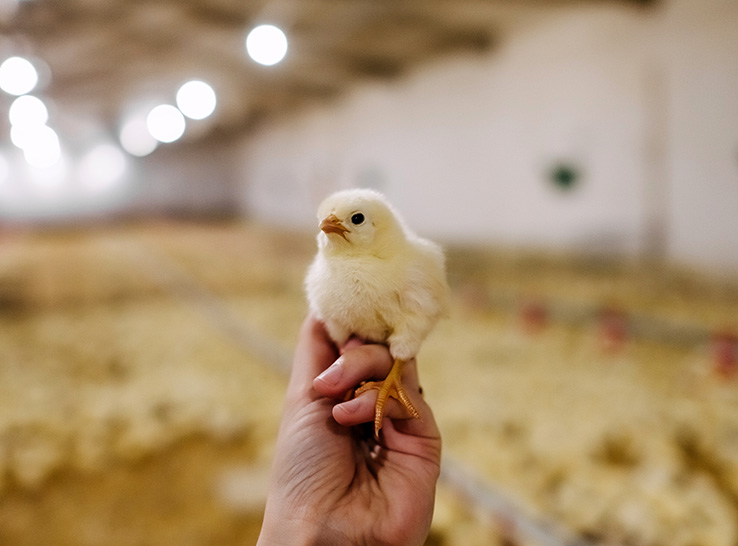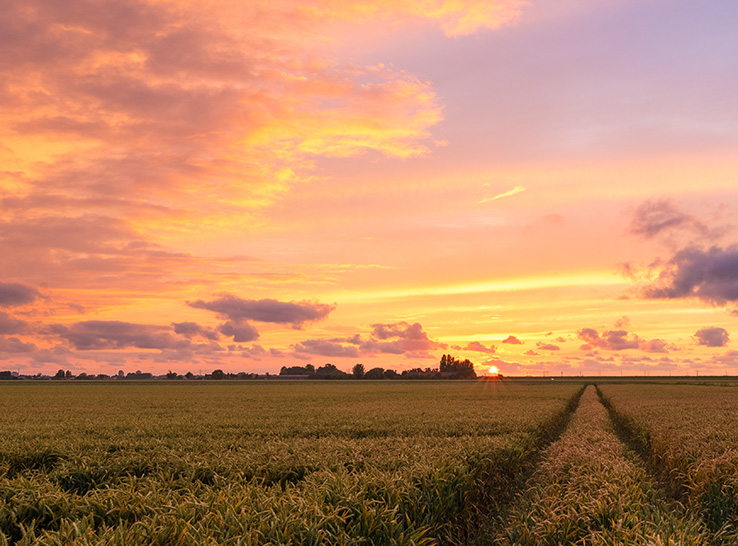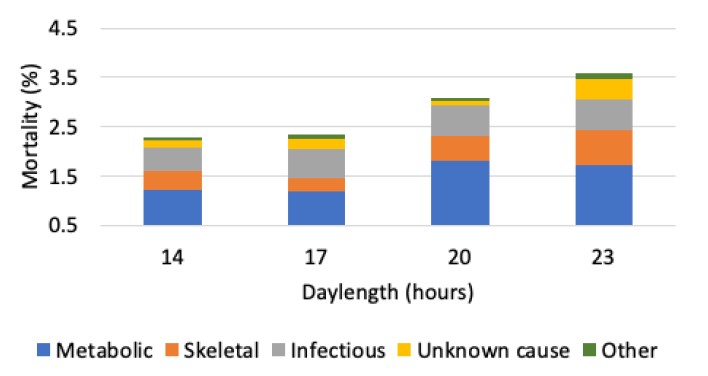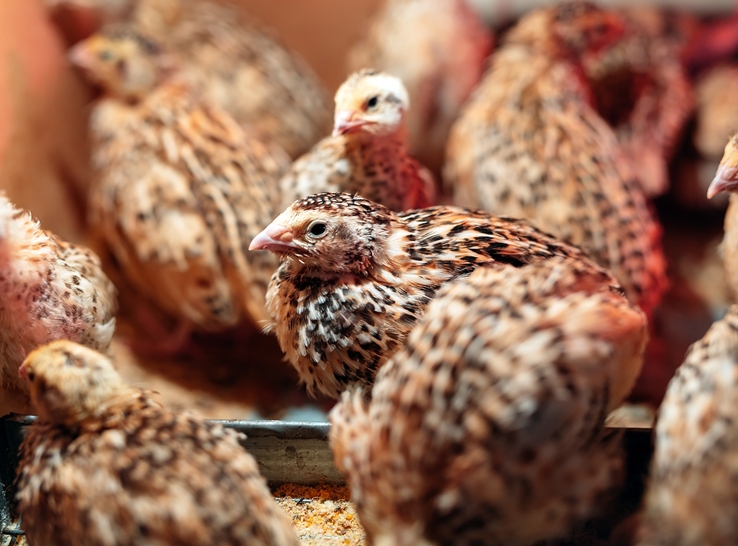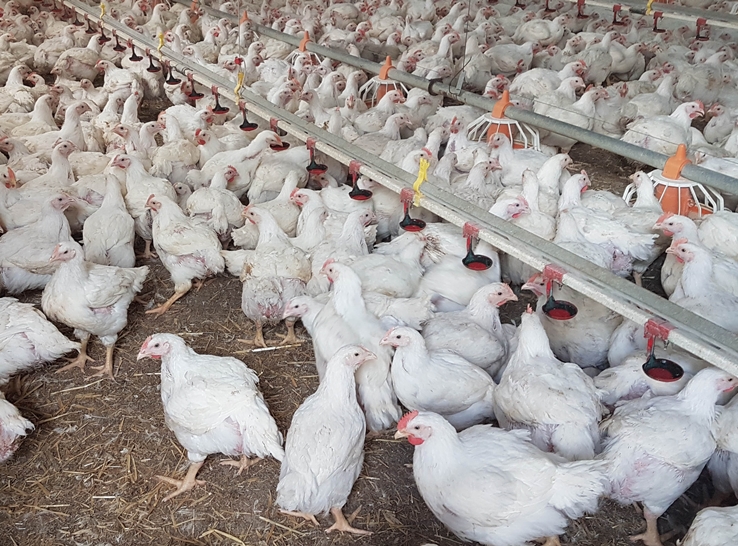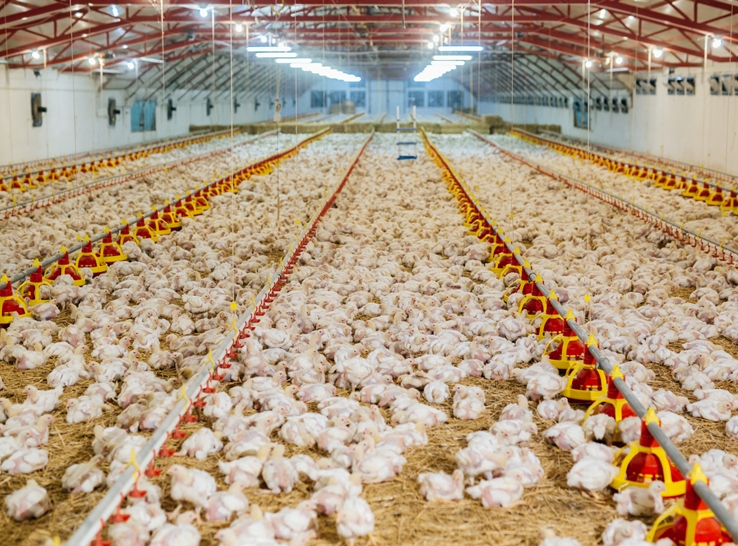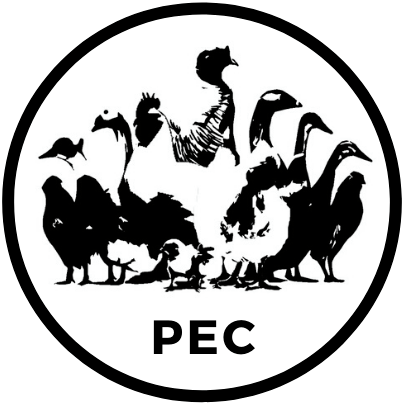By Prafulla Regmi, PhD, University of Georgia
Light and dark cycles within a 24-hour period play a crucial role in maintaining physiological and behavioral rhythms in animals.
In birds, daily rhythms associated with feed intake, physical activity, sleep-wake cycles, and physiological rhythms are influenced by photoperiod. The ancestors of domestic chickens, the Red Junglefowl, are diurnal animals with activity during the light period and inactivity during the dark period.
Commercial broiler farms are often operated with continuous or near-continuous lighting programs, particularly during the first week post-hatch, with the notion that longer daylength increases feed intake and body weight gain. However, providing dark periods of up to 8 hours on a daily basis does not impact the overall production performance. Chickens are capable of adjusting their behavior and feed intake to the photoperiod that is provided. Continuous or near continuous light, however, may disrupt resting or sleeping behaviors.
Current Photoperiod Recommendations for Broilers
Various organizations recommend specific photoperiods for optimal broiler welfare.
- The National Chicken Council in the US advises a 4-hour daily dark period, except for the first and last weeks of growout.
- The National Farm Animal Care Council in Canada requires a gradual increase to 4 hours of darkness by day-5 post-hatch. From day-5 until no sooner than 7 days before catching, a continuous dark period of at least 4 hours within each 24-hour period should be provided.
- The Department for Environment, Food, and Rural Affairs (DEFRA, 2018) in the UK recommends a minimum of 8 hours of darkness.
- The European Union (2007) requires 6 hours of total darkness, with a minimum of 4 hours uninterrupted.
- Broiler breeding companies, such as Aviagen, may recommend specific lighting programs, such as a 1-hour dark period from days 0 to 7 and 4- to 6-hour darkness from day 7 onwards.
Effects of photoperiod on behavior of broilers
Activity levels and resting time:
Broilers exposed to shorter daylengths spent more time on active behaviors and less time on resting behaviors. For instance, housing broilers with 17 hours of light and 7 hours of darkness (17L:7D) resulted in the highest activity levels (15%) whereas those housed with 23L:1D showed the lowest activity (5%) and highest inactive resting (77%) when 4 different lighting programs (14L, 17L, 20L, and 23L) were compared at 4 weeks of age.
Feeding behavior:
The relationship between photoperiod and feeding behavior is complex. Broilers under longer photoperiods (e.g. 23L) eat more while spending less time at the feeder compared to broilers housed under longer dark periods (e.g. 17L). Broilers provided with a dark period display anticipatory feeding behavior, with the highest feeding activity occurring immediately after lights come on and just before lights turn off. Anticipatory feeding is absent in broilers reared under continuous light.
Comfort and exploratory behaviors:
Birds exposed to 4 and 7 hours of darkness exhibit more comfort and exploratory behaviors, including preening and foraging than birds exposed to just 1 hour. This indicates that the duration of the dark period influences not only basic activities, such as eating and sleeping, but also behaviors associated with well-being.
Fear and stress-related behaviors:
Broilers’ fear and stress response varies with different lighting conditions. Birds exposed to 20L and 18L take longer to approach a human than those under 16L and 12L. Similarly, the duration of tonic immobility is also longer in broilers exposed to 20L or 18L birds than 16L or 12L. These observations indicate broilers housed under longer photoperiod are more fearful.
Sleep:
Broilers exposed to 20L and 18L spend more time sleeping than those under 16L and 12L. However, the quality of sleep may be impacted. Even under constant lighting, birds concentrate sleep periods within specific nighttime hours, suggesting that the duration of darkness may influence the restfulness of their sleep.
Impacts of photoperiod on other welfare and health parameters
Mortality rates:
Higher mortality rates have been reported for flocks of broiler chickens that were exposed to long day lengths. Notably, incidences of mortality from metabolic and skeletal issues decrease linearly with increasing inclusion of darkness.
Lameness, gait, and footpad issues:
Longer day lengths correlate with an increase in the number of birds with poor gait and higher average footpad lesion scores. This could be due to an improvement in bone properties of broilers exposed to a shorter photoperiod. Longer and wider tibia with greater mineral content were found in broilers exposed to 12L than 20L. Latency to lie (a proxy indicator of lameness) tends to increase in broilers exposed to shorter photoperiods (12L and 16L) indicating better leg health when compared to broilers reared under longer photoperiods.
Mortality rates by photoperiod
Figure 1: Mortality rate and causes of mortality between 7 to 32 days of age in broilers housed under different photoperiod (Adapted from: Schwean-Lardner et al. 2013. Poult. Sci. 92: 1-11.)
Melatonin and stress hormones:
Continuous lighting (24L) leads to higher levels of stress and inflammatory markers, including corticosterone and circulating IL-6, compared to 18L and 8L conditions. On the other hand, flocks raised under 14L, 17L, and 20L, exhibit rhythmic melatonin concentrations over a 24-hour period. Even during the first week of life, broilers exposed to 4 hours of darkness (or longer) secrete elevated concentrations of melatonin compared to birds exposed to continuous light. In addition to regulating sleep-wake cycles, melatonin rhythms are essential for maintaining immune competence and physiological balance.
Alternative lighting program and broiler welfare
Intermittent lighting
- Reduces leg abnormalities and incidences of sudden death syndrome Lower circulating corticosterone and higher melatonin concentrations compared to near continuous or continuous lighting programs
- Modified circadian and diurnal feeding rhythm under intermittent light with feeding activity mostly centered either 20 min before or 20 min after each dark period
- Shorter tonic immobility times indicating less fearfulness in broilers reared under intermittent lighting
Conclusion
Photoperiod significantly influences broiler well-being, affecting daily activities, feeding behaviors, mortality rates, musculoskeletal health, and hormonal responses. Other factors like light intensity and spectrum also impact behavior and welfare parameters and should be considered when designing lighting programs for the production environment. Uninterrupted dark periods of 4 to 6 hours in a day is recommended for better behavior and welfare outcomes in broilers.
To view all issues of Poultry Press, click here.
Editor’s note: Content on Modern Poultry’s Industry Insights pages is provided and/or commissioned by our sponsors, who assume full responsibility for its accuracy and compliance.

